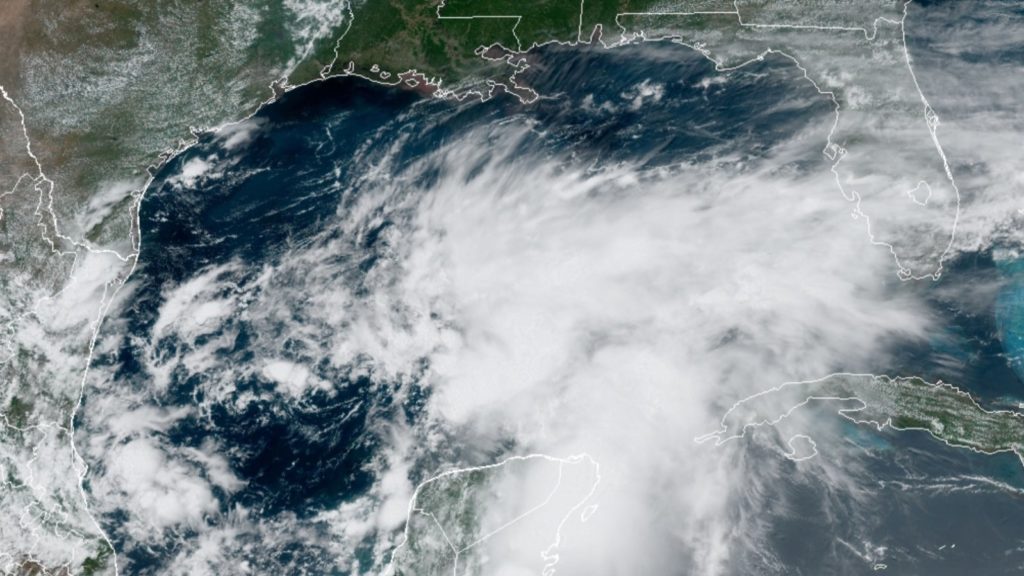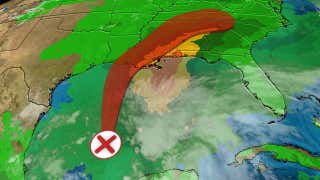
- A tropical or subtropical depression is likely to form in the western Gulf of Mexico Thursday night or Friday.
- This system will bring a threat of heavy rain and possible flooding to the northern Gulf Coast this weekend.
- Storm surge, high surf and rip currents will also be threats at the coast.
A tropical or subtropical depression is expected to form in the western Gulf of Mexico, and no matter how well organized this system becomes, it poses a threat of flooding rain along a part of the northern U.S. Gulf Coast heading into Father’s Day weekend. This system could also contribute to coastal flooding, dangerous rip currents and gusty winds.
Tropical storm conditions are likely along portions of the northern Gulf Coast this weekend and tropical storm warnings have been issued from Intercoastal City, Louisiana to the Alabama/Florida border. This warning includes New Orleans.
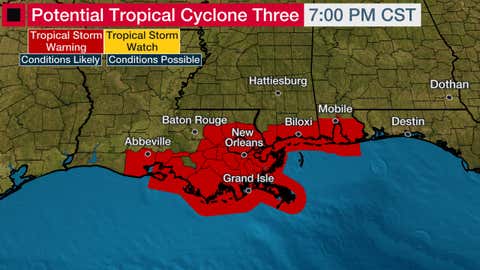
For now, this system is being called a Potential Tropical Cyclone by the National Hurricane Center. This designation is used by the NHC to give an early heads up to residents along the coast that winds of at least 40 mph are possible within the next two days.
(MORE: What is a Potential Tropical Cyclone?)
The National Hurricane Center (NHC) says there is a high chance of a tropical or subtropical depression forming in the western Gulf of Mexico tonight or early Friday.
A subtropical depression or storm has features of both tropical and non-tropical systems. The NHC issues forecasts for these hybrid systems, and they are assigned a number or name just like a tropical depression or storm.
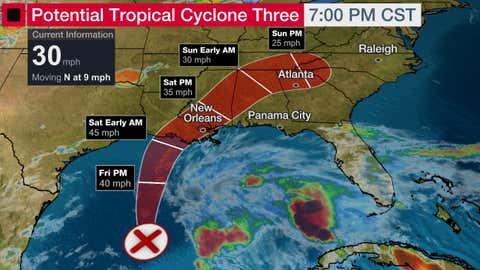
Projected Path and Current Info
(The red-shaded area denotes the potential path of the center of the tropical cyclone. It’s important to note that impacts (particularly heavy rain, high surf, coastal flooding, winds) with any tropical cyclone usually spread beyond its forecast path.)
This system is currently a broad area of low pressure in the central Gulf of Mexico that’s producing somewhat disorganized showers and thunderstorms mainly to the system’s east. Rainfall in that region could trigger flooding in parts of Mexico.
Computer forecast models have been consistently suggesting over the past several days that low pressure may become better defined as it gets drawn northward through the western Gulf of Mexico later today into Friday.
Shop Top Gifts For Dad at The Home Depot (SPONSORED)
Unfavorable upper-level winds (wind shear) and dry air are two factors that should prevent this system from intensifying quickly. Those factors will also keep most of the impacts from this system in areas near and well to the east of where its center of circulation tracks.
The majority of computer model guidance suggests the center of this system will move inland on the northern or northwestern Gulf Coast early this weekend. Impacts like rainfall, higher than normal tides and rip currents could arrive on the northern Gulf Coast by Friday.
Here are the impacts we expect from this system, regardless of what it’s called.
Forecast Impacts
Rainfall Flood Threat
Regardless of the exact track or strength of this system, we expect heavy rain along the northern Gulf Coast beginning as soon as Friday spreading into parts of the Deep South this weekend. This includes already soaked parts of Louisiana and the lower Mississippi Valley.
This system is expected to be lopsided to the right, meaning the heaviest rainfall will be from near the center’s path to the east of the storm.
The heaviest rain is expected from southeast Louisiana into parts of Mississippi, Alabama and the Florida Panhandle. This is where the threat of flash flooding will be highest. Flood watches have been issued in this region.
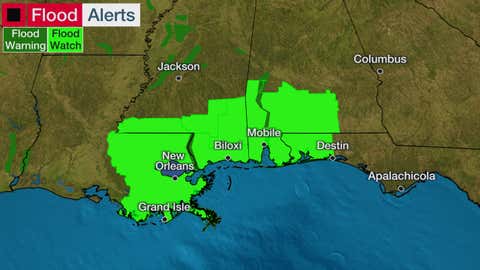
Some soaking rain is also possible in parts of southwest Louisiana and possibly extreme eastern Texas. But, depending on how far east the system tracks, some of those areas could either pick up some heavier rain, or none at all, due to the lopsided nature of this system.
Some locally heavy rain could linger from Alabama and Georgia into the western Carolinas on Sunday, and possibly in the eastern Carolinas and Virginia Monday, as the inland remnant eventually picks up some forward speed. Up to a foot of rainfall is possible from near and east of the landfall point to the southern Appalachians.
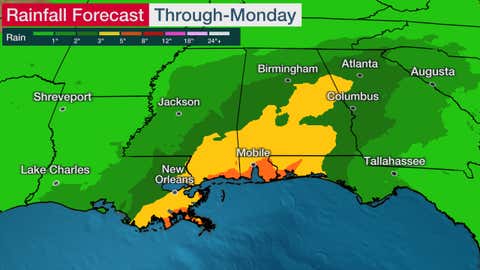
)
Coastal Threats
Coastal flooding will be another impact, especially in vulnerable areas, from Louisiana to potentially as far east as the Florida Panhandle Friday into Saturday.
High surf and dangerous rip currents will also be concerns in this same general area during that time, and beachgoers are advised to stay out of the ocean.
Storm surge will also be possible near the time of high tide from Louisiana to Mobile Bay. Here are the forecast surge heights according to the National Hurricane Center:
- Intracoastal City, LA to MS/AL Border: 2-3 ft
- Vermilion Bay and Lake Borgne: 2-3 ft
- Lake Pontchartrain and Lake Maurepas: 1-2 ft
- MS/AL border to AL/FL border including Mobile Bay: 1-3 ft
- Cameron, LA to Intracoastal City, LA: 1-2 ft
Wind, Tornado Threats
Gusty winds will accompany this system Friday into the weekend on the northern Gulf Coast and possibly into parts of the Deep South.
Even though wind gusts won’t be overly strong, winds may more easily topple trees due to soaked soil from heavy rain. This may also lead to some scattered power outages near the northern Gulf Coast and into the Deep South.
There could be an isolated tornado threat Friday into Saturday from southern Louisiana into southern Alabama, southern Mississippi and the western Florida Panhandle.
June Gulf Storms
June storms in the Gulf of Mexico are fairly typical.
Since 2000, there have 16 named storms in the Gulf of Mexico. Eleven of those made a U.S. landfall.
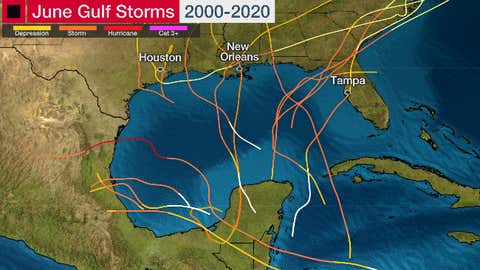
Tracks of all June Gulf of Mexico named storms from 2000 through 2020.
(Data: NOAA/NHC)
The most recent one was last year. Tropical Storm Cristobal formed from the remnant of eastern Pacific Tropical Storm Amanda, then made landfall in southeast Louisiana.
Other June Gulf storms were prolific flood producers, including Debby in 2012 in Florida and Allison’s $9 billion flood in 2001 in Houston.
The last June Gulf hurricane was in 2010.
Hurricane Alex made a Category 2 landfall in northeast Mexico triggered massive flooding in Monterrey, Mexico, where up to 35 inches of rain fell.
June Gulf U.S. hurricane landfalls are extremely rare. The last one was Hurricane Bonnie, 35 years ago.
The Weather Company’s primary journalistic mission is to report on breaking weather news, the environment and the importance of science to our lives. This story does not necessarily represent the position of our parent company, IBM.
